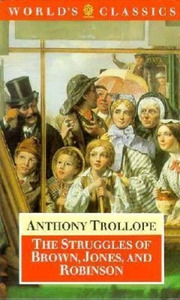
Trollope intended The Struggles of Brown, Jones and Robinson (1870) as “a hit at the present system of advertising”. Unfortunately, his unappreciative audience thought it a flop, with one critic dismissing it as “Thackeray-and-water”. As is often the case, I find myself almost alone in thinking it one of the author’s triumphs.
The story charts the rise and fall of a haberdashery business run by the eponymous characters. Brown is pathologically cautious, a situation that repeatedly brings him into conflict with his extravagant and acquisitive partners. To complicate matters further, Robinson determines to win the hand of Brown’s youngest daughter, thereby pitching himself into competition with Brisket the butcher, who is as beefy as his name suggests. Meanwhile, the ambitious Jones seeks to corner the market in stockings and quash Robinson’s more exotic plan to stock monkey muffs (I shall resist the temptation to speculate on that item).
Robinson is a great believer in the power of advertising and bling. When they secure their premises at 81 Bishopsgate, the building is painted magenta from top to bottom, and Robinson declares: “Outside there should be glass, gas, gold, and glare. Inside there should be the same, with plenty of brass, and if possible a little wit.” He aspires to “retain every available shilling for advertisements … £4,000 scattered broadcast through the metropolis on walls, omnibuses, railway stations, little books, pavement chalking, illuminated notices, porters’ backs, gilded cars, and men in armour.” He comes up with the slogan of “Nine times nine is eighty-one”, inspired by their location – a meaningless slogan for an entirely specious business.
The flimsy story almost buckles under the weight of Trollope’s parody, but his comic skill is tremendous. Trollope’s sharp wit abounds in his spoof copy-writing and advertising campaigns, giving the reader a delicious evocation of mid-Victorian commerce. As Victoria Glendinning declares in her superb biography: “Bad fiction provides nuggets of social history unobtainable elsewhere.” 1 There are countless parallels to be drawn with the modern advertising industry, with its emphasis on style over substance and businesses valued at squillions of pounds even before they’ve actually produced anything. John Sutherland concludes of Struggles that “the work remains odd”. However, one of the many things I love about Trollope is his relentless desire to flirt with new styles. His readers often reacted angrily at what they saw as an unwarranted deviation from a successful format, but it does make him endlessly fascinating as a writer. In his Autobiography, Trollope wrote: “It was meant to be funny, was full of slang, and was intended as a satire on the ways of trade … I think there is some good fun in it, but I have heard no one else express such an opinion.” Well, 150 years after it was originally serialised, I concur wholeheartedly with the author: it’s good fun.
The Struggles of Brown, Jones and Robinson by Anthony Trollope
Trollope by Victoria Glendinning ↩︎